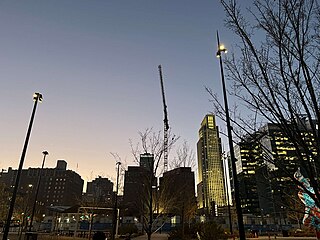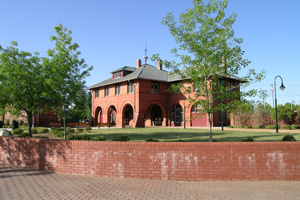
Fayetteville is the second-most populous city in the U.S. state of Arkansas, the county seat of Washington County, and the most populous city in Northwest Arkansas. The city had a population of 93,949 as of the 2020 census, which was estimated to have increased to 101,680 by 2023. The city is on the outskirts of the Boston Mountains, within the Ozarks. It was named after Fayetteville, Tennessee, from which many settlers had come, and was incorporated on November 3, 1836. Fayetteville is included in the three-county Fayetteville–Springdale–Rogers metropolitan statistical area, with 576,403 residents in 2020.

Waynesville is the county seat of Haywood County, North Carolina, United States. It is the largest town in North Carolina west of Asheville. Waynesville is located about 30 miles (50 km) southwest of Asheville between the Great Smoky and Blue Ridge Mountains.

Marion is a city in and the county seat of McDowell County, North Carolina, United States. Founded in 1844, the city was named in honor of Brigadier General Francis Marion, the American Revolutionary War Hero whose talent in guerrilla warfare earned him the name "Swamp Fox". Marion's Main Street Historic District is listed on the National Register of Historic Places. The population was 7,717 at the 2020 Census.

Lumberton is a city in Robeson County, North Carolina, United States. As of 2020, its population was 19,025. It is the county seat of Robeson County.

The North Carolina State Capitol is the former seat of the legislature of the U.S. state of North Carolina which housed all of the state's government until 1888. The Supreme Court and State Library moved into a separate building in 1888, and the General Assembly moved into the State Legislative Building in 1963. Today, the governor and his immediate staff occupy offices on the first floor of the Capitol.

Samuel Sloan was a Philadelphia-based architect and best-selling author of architecture books in the mid-19th century. He specialized in Italianate villas and country houses, churches, and institutional buildings. His most famous building—the octagonal mansion "Longwood" in Natchez, Mississippi—is unfinished; construction was abandoned during the American Civil War.

Rockford is an unincorporated community and former town in southern Surry County, North Carolina, United States.

Fayetteville Street is a major street in downtown Raleigh, North Carolina, United States of America. It is a north-south thoroughfare that connects the State Capitol to the Raleigh Convention Center and the Progress Energy Center for the Performing Arts. It is the City of Raleigh's ceremonial center, hosting parades, special events, and seasonal celebrations.

Downtown Omaha is the central business, government and social core of the Omaha–Council Bluffs metropolitan area, U.S. state of Nebraska. The boundaries are Omaha's 20th Street on the west to the Missouri River on the east and the centerline of Leavenworth Street on the south to the centerline of Chicago Street on the north, also including the CHI Health Center Omaha. Downtown sits on the Missouri River, with commanding views from the tallest skyscrapers.

The Market House is a market house and town hall in the center of Fayetteville, Cumberland County, North Carolina. It was built in 1838 on the site of the old state house and Town Hall which burned down in 1831. Fayetteville was the capital of North Carolina from 1789 to 1794.

Heritage Square is a place in Fayetteville, North Carolina. Owned and maintained by The Woman's Club of Fayetteville, Heritage Square includes the Sandford House, built in 1797; the Oval Ballroom, a freestanding single room built in 1818; and the Baker-Haigh-Nimocks House, constructed in 1804. The buildings located on Heritage Square are listed in the National Register of Historic Places as the "Fayetteville Woman's Club and Oval Ballroom" and "Nimocks House."

William Lee Stoddart (1868–1940) was an architect who designed urban hotels in the Eastern United States. Although he was born in Tenafly, New Jersey, most of his commissions were in the South. He maintained offices in Atlanta and New York City.

The Washington County Courthouse is the name of a current courthouse and that of a historic one in Fayetteville, Arkansas, the county seat of Washington County. The historic building, built in 1905, was listed on the National Register of Historic Places in 1972. The historic courthouse is the fifth building to serve Washington County, with the prior buildings located on the Historic Square where the Old Post Office is today. The building is one of the prominent historic buildings that compose the Fayetteville skyline, in addition to Old Main.

The Fayetteville Historic Square, in Fayetteville, Arkansas, includes the original Fayetteville post office, the Old Bank of Fayetteville Building, the Lewis Brothers Building, the Mrs. Young Building, and the Guisinger Building. These buildings are listed in the National Register of Historic Places. There are several more recent buildings located on the Square.
The following is a timeline of the history of the city of Raleigh, North Carolina, USA.

Cape Fear and Yadkin Valley Railway Passenger Depot is a historic train station located at 325 Franklin Street in Fayetteville, North Carolina. It was built in 1890 by the Cape Fear and Yadkin Valley Railway. It is a two-story brick passenger depot with a deep hip roof in the Romanesque Revival style. The seven bay by two bay building features a rounded brick arch arcade. It was listed on the National Register of Historic Places in 1983.

Fayetteville Downtown Historic District is a national historic district located in Fayetteville, Cumberland County, North Carolina. It encompasses 113 contributing buildings, 3 contributing sites, 1 contributing structure, and 2 contributing objects in the central business district of Fayetteville. The district includes commercial buildings, government and civic buildings, railroad-related structures, residential dwellings, churches and the Cross Creek Cemetery. They range in build date from the 1780s to 1949. The district includes the previously listed Liberty Row and Market House Square District and 16 resources listed as part of the "Historic Resources of Fayetteville," a Multiple Resource Nomination.

Haymount District, also known as Haymount Historic District, is a national historic district located at Fayetteville, Cumberland County, North Carolina. It encompasses 60 contributing buildings and 1 contributing site in a primarily residential section of Fayetteville. The dwellings were built between about 1817 and 1950, and include notable examples of Queen Anne and Colonial Revival style architecture. The earliest extant residence is the Robert Strange Town House, home of Senator Robert Strange (1796-1854). Another notable building is the Highsmith Memorial Hospital, designed by architect Charles C. Hartmann and completed in 1926. Also located in the district is the separately listed Edgar Allan Poe House.

The North Carolina State House was built from 1792 to 1796 as the state capitol for North Carolina. It was located at Union Square in the state capital, Raleigh, in Wake County. The building was extensively renovated in the neoclassical style by William Nichols, the state architect, from 1820 to 1824. On December 24, 1821, the statue of George Washington by Antonio Canova was displayed in the rotunda. Both were destroyed by fire in 1831.






















